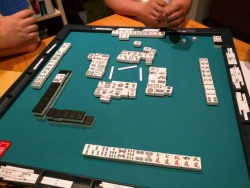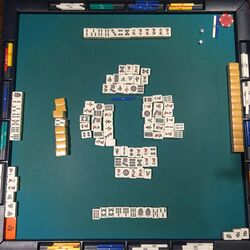Tochuu ryuukyoku: Difference between revisions
m (→Suukaikan) |
|||
| (46 intermediate revisions by 8 users not shown) | |||
| Line 1: | Line 1: | ||
'''Tochuu | [[Image:Kokushi_Suucha_Riichi.jpg|thumb|250px|right|A suucha riichi draw with real tiles, where a player was tenpai for [[kokushi musou]].]] '''Tochuu ryuukyoku''' {{kana|途中流局}}, or "abortive draw" in English, refers to the special cases where the [[kyoku|hand]] ends without a win and before [[Ryuukyoku|running out of tiles]] from the wall. | ||
== | ==Process== | ||
In the event of tochuu ryuukyoku, the current hand is instantly aborted. Furthermore: | |||
In the event of tochuu | * No points are exchanged between players. Instead, the tiles are reshuffled again for the next hand. | ||
* No points are exchanged between players | |||
* The noten penalty per [[Ryuukyoku|exhaustive draw]] is not applied. | * The noten penalty per [[Ryuukyoku|exhaustive draw]] is not applied. | ||
* [[Riichi]] declarers do not have to reveal their hand, except in face of four riichi. | * [[Riichi]] declarers do not have to reveal their hand, except in face of four riichi. | ||
* All riichi bets remain on the table and can be won during the next hand. | * All riichi bets remain on the table and can be won during the next hand. | ||
* As with an [[Ryuukyoku|exhaustive draw]], the [[honba]] count increases by one. | * As with an [[Ryuukyoku|exhaustive draw]], the [[honba]] count increases by one. | ||
* | * The seat winds do not rotate for the next hand. | ||
Essentially, play resumes as if the previous hand did not occur, except with the additional honba count. | Essentially, play resumes as if the previous hand did not occur, except with the additional honba count and previous riichi bets. | ||
With the exception of kyuushu kyuuhai, all cases of tochuu ryuukyoku are mandatory when they occur. | |||
== Suufon renda == | |||
[http://tenhou.net/0/?log=2015090309gm-0009-7447-fa717ec6&tw=0&ts=7 Example] | |||
'''Suufon renda''' {{kana|四風連打}} means "consecutively (ren) discarding (da) four (suu) winds (fon)". When all four players' initial discards are the same wind type, suufon renda is triggered, and the hand is aborted. In other words, each player must have [[haipai|started]] with a wind type and chose to discard it. A call for [[kan]] invalidates the abortive draw. | |||
== Kyuushu kyuuhai == | |||
=== | [http://tenhou.net/0/?log=2014011202gm-0089-0000-c5a5f508&tw=0&ts=1 Example] | ||
'''Kyuushu kyuuhai''' {{kana|九種九牌}} literally means 9 (kyuu) kinds (shu) of honor or terminal (kyuu) tiles (hai). It is essentially the game's invocation of the "[https://en.wikipedia.org/wiki/Mulligan_(games) Mulligan rule]". | |||
When a player's 14-tile hand after the initial draw has 9 different types of honor/terminal tile, the player may announce this, reveal their hand, and invoke the abortive draw. If any [[naki|tile calls]] (inc. closed [[kan]]) have been made, then players can no longer declare kyuushu kyuuhai. Note that a pair of honor/terminal tiles counts as one "type" of tile. | |||
== Suucha riichi == | |||
[http://tenhou.net/0/?log=2014081419gm-0009-7447-b66ad799&tw=0&ts=6 Example] | |||
'''Suucha riichi''' {{kana|四家立直}}, literally meaning "four players [[riichi]]", is declared when all four players have declared riichi successfully. Once the fourth player declares riichi, and the discarded tile is not won off of, the hand is ended immediately. If the fourth player's discarded tile deals in to another player, suucha riichi is not triggered, and the winning player(s) score like normal. | |||
After suucha riichi, all players must reveal their hands. Players without tenpai hands are punished with a [[chombo]] for declaring riichi while noten. If the hands are valid riichi calls, then the game proceeds like any other abortive draw. | |||
[ | == Suukaikan == | ||
[http://tenhou.net/0/?log=2014021417gm-0009-7447-00d6d80f&tw=3&ts=5 Example] | |||
'''Suukaikan''' {{kana|四開槓}} is declared when a combined total of four [[kan|quads]] are formed by different players. It is literally "open (kai) four (suu) kans", but the kans do not have to be "open" to trigger suukaikan. After the fourth kan is called, the hand is aborted: | |||
* Most rules abort the hand when the following discard is not a winning tile. | * Most rules abort the hand when the following discard is not a winning tile. | ||
* Some rules end the game | * Some rules end the game before the [[rinshan]] draw happens. However, a player eligible for [[chankan]] can still win before the draw happens. | ||
If all four quads are called by one player, play continues to give the player the opportunity to score the yakuman, [[suukantsu]]. | |||
*In most rulesets, players are ''not'' allowed to call a fifth kan to invoke the abortive draw. Calling the fifth kan is simply not allowed. | |||
*In a few rulesets, players can call a fifth kan to invoke an abortive draw. In this case, the hand ends before chankan and the rinshan draw happen. | |||
Even if abortive draws are not used, players may only declare a total of four kans in one game. This is because there are only 4 tiles available for rinshan draws; a fifth kan would start drawing from the uradora indicators. | |||
allow | |||
==Sanchahou== | |||
[[Image:Sanchahou.jpg|thumb|right|250px|Sanchahou invoked on dora [[houtei]].]] | |||
[http://tenhou.net/0/?log=2015041415gm-00a9-0000-6cda8438&ts=1&tw=1 Example] | |||
'''Sanchahou''' {{kana|三家和}}, literally "three (san) players (cha) win (hou)", occurs when three players call ''ron'' on the same discard. When this happpens, the hand ends, and no points are paid. Some rules allow this "triple ron"; others use [[atamahane]] (so only one player gets points). | |||
==Rule variations== | |||
Any or all of the abortive draws may be subject to rule variations. In many real life settings, abortive draws are not used, in order to avoid wasting time. Abortive draws may also be disabled in order to make the game harder. | |||
==External links== | ==External links== | ||
Latest revision as of 17:42, 12 April 2024

Tochuu ryuukyoku 「途中流局」, or "abortive draw" in English, refers to the special cases where the hand ends without a win and before running out of tiles from the wall.
Process
In the event of tochuu ryuukyoku, the current hand is instantly aborted. Furthermore:
- No points are exchanged between players. Instead, the tiles are reshuffled again for the next hand.
- The noten penalty per exhaustive draw is not applied.
- Riichi declarers do not have to reveal their hand, except in face of four riichi.
- All riichi bets remain on the table and can be won during the next hand.
- As with an exhaustive draw, the honba count increases by one.
- The seat winds do not rotate for the next hand.
Essentially, play resumes as if the previous hand did not occur, except with the additional honba count and previous riichi bets.
With the exception of kyuushu kyuuhai, all cases of tochuu ryuukyoku are mandatory when they occur.
Suufon renda
Suufon renda 「四風連打」 means "consecutively (ren) discarding (da) four (suu) winds (fon)". When all four players' initial discards are the same wind type, suufon renda is triggered, and the hand is aborted. In other words, each player must have started with a wind type and chose to discard it. A call for kan invalidates the abortive draw.
Kyuushu kyuuhai
Kyuushu kyuuhai 「九種九牌」 literally means 9 (kyuu) kinds (shu) of honor or terminal (kyuu) tiles (hai). It is essentially the game's invocation of the "Mulligan rule".
When a player's 14-tile hand after the initial draw has 9 different types of honor/terminal tile, the player may announce this, reveal their hand, and invoke the abortive draw. If any tile calls (inc. closed kan) have been made, then players can no longer declare kyuushu kyuuhai. Note that a pair of honor/terminal tiles counts as one "type" of tile.
Suucha riichi
Suucha riichi 「四家立直」, literally meaning "four players riichi", is declared when all four players have declared riichi successfully. Once the fourth player declares riichi, and the discarded tile is not won off of, the hand is ended immediately. If the fourth player's discarded tile deals in to another player, suucha riichi is not triggered, and the winning player(s) score like normal.
After suucha riichi, all players must reveal their hands. Players without tenpai hands are punished with a chombo for declaring riichi while noten. If the hands are valid riichi calls, then the game proceeds like any other abortive draw.
Suukaikan
Suukaikan 「四開槓」 is declared when a combined total of four quads are formed by different players. It is literally "open (kai) four (suu) kans", but the kans do not have to be "open" to trigger suukaikan. After the fourth kan is called, the hand is aborted:
- Most rules abort the hand when the following discard is not a winning tile.
- Some rules end the game before the rinshan draw happens. However, a player eligible for chankan can still win before the draw happens.
If all four quads are called by one player, play continues to give the player the opportunity to score the yakuman, suukantsu.
- In most rulesets, players are not allowed to call a fifth kan to invoke the abortive draw. Calling the fifth kan is simply not allowed.
- In a few rulesets, players can call a fifth kan to invoke an abortive draw. In this case, the hand ends before chankan and the rinshan draw happen.
Even if abortive draws are not used, players may only declare a total of four kans in one game. This is because there are only 4 tiles available for rinshan draws; a fifth kan would start drawing from the uradora indicators.
Sanchahou

Sanchahou 「三家和」, literally "three (san) players (cha) win (hou)", occurs when three players call ron on the same discard. When this happpens, the hand ends, and no points are paid. Some rules allow this "triple ron"; others use atamahane (so only one player gets points).
Rule variations
Any or all of the abortive draws may be subject to rule variations. In many real life settings, abortive draws are not used, in order to avoid wasting time. Abortive draws may also be disabled in order to make the game harder.
External links
- Tochuu ryuukyoku in Japanese Wikipedia